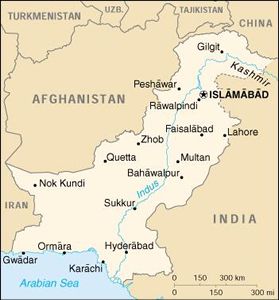
Urdu
Urdū belongs to the Indo-Aryan branch of the Indo-European language family. It is spoken as a first language by 64 million people in Pakistan and India, and by 94 million people as a second language in Pakistan. It is also spoken in urban Afghanistan, in the major urban centers of the Persian Gulf countries and Saudi Arabia. There is a large Urdū-speaking diaspora in the United Kingdom, the United States,Canada, Norway and Australia.
 Hindi vs. Urdū
Hindi vs. Urdū
The name Hindi is of Persian origin. The Persians used it to refer to the Indian people and to the languages they spoke. Scholars postulate that Hindi developed in the 8th-10th centuries from khari boli , spoken around Dehli and adopted by the Moslem invaders to communicate with the local population. Eventually, it developed into a variety called Urdū (from Turkish ordu ‘camp’), characterized by numerous borrowings from Persian and Arabic, which became a literary language. In the meantime, the language of the indigenous population remained relatively free of borrowings from Persian and Arabic, and instead borrowed words and literary conventions from Sanskrit. This language became Hindi.
As a result of these different influences, Hindi is written in the Devanagari script and draws much of its vocabulary from Sanskrit, while Urdū is written in the Perso-Arabic script and draws a great deal of its lexicon from Persian and Arabic. The two languages also differ in a number of relatively minor ways in their sound system and grammar. Both Hindi and Urdū have been used as literary languages starting in the 12th century.
Hindi and Urdū have a common colloquial form, called Hindustani. Hindustani never achieved the status of a literary language, although Mahatma Ghandi used it as a symbol of national unity during India’s struggle for independence from England.
Status
Pakistan
Urdū is the official language of Pakistan, along with English. It is the 2nd or 3rd language for Pakistanis for whom it is not a native language. All government, business, media, and education are conducted in Urdū.
India
Urdū is one of the 22 official languages of India. It has official status in the Indian states of Andhra Pradesh, Delhi, Jammu and Kashmir, and Uttar Pradesh where it is used in government administration and as the medium of instruction in primary schools. Throughout India, Urdū is typically spoken by Moslems, whereas Hindi is typically spoken by Hindus. India has several thousand daily Urdū newspapers. There are Urdū schools with their own curriculum.
Even though India and Pakistan became independent from England in 1947, English continues to play such a major social and educational role that education in English is a prerequisite for social status in both countries. English remains the sole language of higher education in almost every field of learning, and code-switching between Hindi/Urdū and English is extremely common, especially among the educated elite. English continues to be a necessity for Pakistan, a country where the majority of the people speak Punjabi and where a large number of other languages are used on a daily basis.
Click on the MLA Interactive Language Map to find out where Hindi/Urdū are spoken in the U.S.
Dialects
Urdū is usually divided into four mutually intelligible dialects that, for the most part, are also intelligible to speakers of Hindi:
- Dakhini is spoken in the Maharashtra state in India and around Hyderabad. It has fewer Persian and Arabic words than standard Urdū.
- Pinjari
- Rekhta is the language of Urdū poetry.
- Modern Vernacular Urdū is spoken in the large cities, such as Delhi, Lucknow, Karachi and Lahore.
Structure
Sound system
The sound system of Hindi/Urdū is fairly typical of Indo-Aryan languages.
Hindi/Urdū have 11 oral vowel phonemes, i.e., sounds that differentiate word meaning. Vowels can be oral or nasal. Nasalization makes a difference in word meaning, e.g., ak ‘a plant,’ ãk ‘draw.’
Vowels
Urdū has 11 oral vowel phonemes, i.e., sounds that differentiate word meaning. Vowels can be oral or nasal. Nasalization makes a difference in word meaning, e.g., ak ‘a plant,’ ãk ‘draw.’
| Close |
i
|
u
|
|
| Near-close |
ʊ
|
||
| Mid |
e
|
ə
|
|
| Open-Mid |
ε
|
ɔ
|
|
| Near-open |
æ
|
||
| Open |
- /i/ = ea in peat
- /I/ = i in pit
- /e/ = e in pet
- /ε/ = i in girl
- /æ/ = a in pat
- /ə/ = a in ago
- /u/ = oo in too
- /ʊ/ = oo in good
- // = oo in bog
- /α/ = a in car
Consonants
Urdū has a large consonant inventory. The use of consonant clusters is extremely limited, even in borrowed words. They occur mostly in initial and medial position. Only a restricted set of consonant clusters can occur at the end of words. Consonants can be geminated (doubled) in medial position.
The exact number of consonants is difficult to determine due to regional differences in pronunciation. In addition, the extent to which consonant sounds that appear only in borrowed words should be considered part of Standard Urdū is also a matter of debate. In the table below, consonants that do not occur in all varieties of Urdū, and those that occur primarily in borrowings are given in parentheses.
| Stops | unaspirated voiceless |
t
|
ʈ
|
(q)
|
|||||
| aspirated voiceless |
pʰ
|
tʰ
|
ʈʰ
|
kʰ
|
|||||
| unaspirated voiced |
ɖ
|
||||||||
| aspirated voiced |
bʰ
|
dʰ
|
ɖʰ
|
gʰ
|
|||||
| Fricatives | voiceless |
(f)
|
.s
|
ʃ
|
(x)
|
||||
| voiced |
(z)
|
(ʒ)
|
(ɣ)
|
||||||
| Affricates | unaspirated voiceless |
.
|
ts
|
tʃ
|
|||||
|
tʃʰ
|
|||||||||
| unaspirated voiced |
dʒ
|
||||||||
| aspirated voiced |
dʒʰ
|
||||||||
| Nasals | …… |
..ɳ
|
ŋ
|
||||||
| Laterals | ….. |
..ɭ
|
|||||||
| Flap or trill | unaspirated |
ɽ
|
|||||||
| aspirated |
ɽʰ
|
||||||||
| Approximant |
ʋ
|
- There is a contrast between short and long consonants, e.g., pəta ‘address’ and pətta ‘leaf.’
- There is a contrast between aspirated vs. unaspirated stops and affricates, including voiced ones, e.g., p—pʰ, t—tʰ, k—kʰ, b—bʰ, d—dʰ, g—gʰ, ʈ—ʈʰ, etc. Aspirated consonants are produced with a strong puff of air.
- There is a contrast between and apical and retroflex consonants, e.g., /t/ – /ʈ/, /d/ – /ɖ/, /n/ – /ɳ/. Apical consonants are produced with the tip of the tongue touching the roof of the mouth, whereas retroflex consonants are produced with the tongue curled, so that its underside comes in contact with the roof of the mouth.
- /ʋ/ is often pronounced as /v/.
- /ʃ/ = sh in shop
- /tʃ/ = ch in chop
- /dʒ/ = j in job
- /j/ = y in yet
Stress
Stress in Urdū normally falls on the penultimate (i.e., next to the last) syllable of a word. The position of stress alone does not affect word meaning.
Grammar
Urdū is a highly inflected language which utilizes prefixes and suffixes to form words and to express grammatical relations. It uses postpositions, rather than prepositions, to express various case relationships. Postpositions require that the nouns be used in the oblique case.
Nouns, adjectives, and pronouns
Urdū nouns are marked for the following categories:
- number: singular and plural;
- gender: masculine and feminine;
- case: direct, oblique, and vocative;
- The direct case is used to mark subjects of a sentence; the oblique case is used with postpositions.
- There are four declensional paradigms for masculine and four for feminine nouns.
- Adjectives agree with the nouns they modify in number, case, and case. They have fewer case forms than nouns.
- Pronouns have more case forms than nouns;
- 3rd-person pronouns are the same as proximate and remote demonstratives yəh ‘this and vəh ‘that.’
- There is a 2nd-person honorific pronoun ap which is used with both singular/plural and male/female addressees.
Verbs
Urdū verbs are marked for the following characteristics:
- Verbs occur in the following forms: root (kha ‘eat’), imperfect stem (khatA), perfect stem (khayA), and infinitive (khanA). The stems agree with nouns in gender and number. ;
- person: 1st, 2nd, 2nd honorific, 3rd;
- number: singular and plural;
- tense: present, past, future;
- tense distinction of present vs. past is expressed by the auxiliary verb honA ‘to be.’
- aspect: imperfective and perfective;
- mood: indicative, imperative, optative.
Politeness
Second-person personal pronouns are marked for three levels of politeness. Verbs in the 2nd person are also marked for politeness.
- singular form tu (informal, extremely intimate, or disrespectful)
- singular form tum (informal and showing intimacy)
- plural form ap (formal and respectful)
Word order
rdū word order is typically Subject-Object-Verb. Modifiers precede the nouns they modify.
Vocabulary
Urdū has borrowed much of its formal and technical vocabulary from Persian and Arabic due Arabic influence. In general, words of Persian origin, e.g., mard ‘man’ are considered more formal than words of Hindi origin, e.g., ādmi ‘man.’ Like Hindi, Urdū has borrowed a large number of words from English.
Here are a few common phrases in Urdū:
| Hello | Salam |
| Good bye | Alwidāh |
| Thank you | Shukriya |
| Excuse me, I am sorry | Maf kijiye. |
| Please | Xush kama |
| Yes | Jī han. |
| No | Jī nahīn |
| Man | ādmi, mard |
| Woman | Oarat |
Below are Urdū numerals 0-10 in in Perso-Arabic script and in romanization.
Writing
Urdū has been written since the 12th century in the Perso-Arabic script, an adaptation of the Persian alphabet, which, in turn, is derived from the Arabic alphabet.It is typically written in the Nasta’liq style which is difficult to typeset. As a result, Urdū newspapers were printed from hand-written masters until the late 1980s. The daily Jang was the first Urdū newspaper composed in Nasta’liq on the computer. Efforts are underway to develop more user-friendly Urdū support for computers and the Internet.
- Perso-Arabic script
The Perso-Arabic script is written from right to left and is composed of 28 basic letters. Adaptations of the script for other languages such as Persian and Urdū have additional letters. There is no difference between upper and lower case, nor between written and printed letters. Most of the letters are attached to one another, even when printed, and their appearance changes as a function of whether they are connected to the preceding or following letters. Some combinations of letters form ligatures. Short vowels are not written, though long ones are—so the reader must know the language in order to restore the vowels. However, in editions of the Qur’an vowels are used – including a sign for vowel omission. - Roman Urdū
Urdū is sometimes also written in the Roman script. Roman Urdū has been used since the British Raj, due to the availability and low cost of Romanmovable type. Roman Urdū is regaining popularity among users of text-messaging and Internet services and is developing its own style and conventions. Bollywood and Lollywood use Roman Urdū for their movie titles.
Take a look at Article 1 of the Universal Declaration of Human Rights in Urdū in the Perso-Arabic and Roman scripts.
Did You Know?
English has borrowed a few words from Urdū. Here are two of them.
|
English
|
from Urdū
|
|---|---|
|
khaki
|
khaki, literally ‘dusty,’ from khak ‘dust’ |
|
tandoori
|
type of Indian cooking, from Urdū or Punjabi tandur ‘cooking stove’ |
Difficulty

Urdū is a Category II language in terms of difficulty for speakers of English.
 Hindi vs. Urdū
Hindi vs. Urdū
